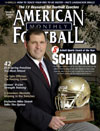AMERICAN FOOTBALL MONTHLY THE #1 RESOURCE FOR FOOTBALL COACHES
Article CategoriesAFM Magazine
|
The Tools to be a LinebackerStrategy & Techniqueby: Jim Dostal Defensive Coordinator, Prairie High School, Cedar Rapids, IA © More from this issue Defining A Hawk Linebacker: In the 50 front, which is the Hawk base defense, the two linebackers are labeled Sam and Will. Sam is historically the strong side linebacker based around the offensive set and normally lines up on the tight end side. The other linebacker is labeled Will and normally plays on the split-end side of the offensive set. In an offensive set that has two tight ends the Sam linebacker will position himself on the tight end side that has the flanker present or a power back. Stance: In a base stance the feet will be parallel to the LOS (line of scrimmage). There can be a small stagger by the player between the right and left foot; this should be consistent every time so the offense does not pick up a tendency. Knees should be bent based on the player’s comfort level. Heels of the feet should b....The full article can only be seen by subscribers. Subscribe today!
|
|
|||||||
| HOME |
MAGAZINE |
SUBSCRIBE | ONLINE COLUMNISTS | COACHING VIDEOS |
Copyright 2025, AmericanFootballMonthly.com
All Rights Reserved





